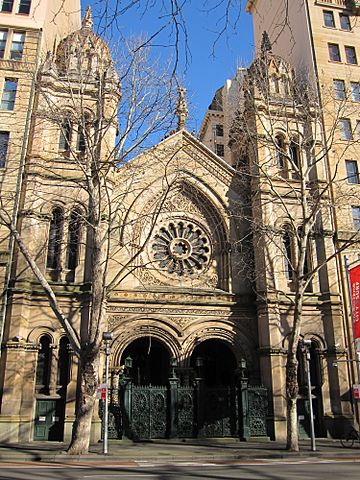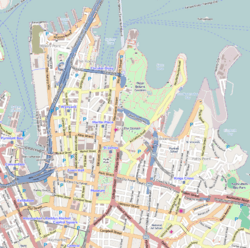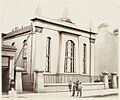Great Synagogue (Sydney) facts for kids
Quick facts for kids The Great Synagogue |
|
|---|---|

The Great Synagogue facade and front entrance in Elizabeth Street
|
|
| Religion | |
| Affiliation | Orthodox Judaism |
| Ecclesiastical or organizational status | Active |
| Leadership | Rabbi Dr. Benjamin Elton, Chief Minister and Senior Rabbi.
Rabbi Menachem Feldman, Chazzan and Assistant Rabbi David Lewis, President |
| Year consecrated | 4 March 1878 |
| Location | |
| Location | 187a Elizabeth Street and 164-166 Castlereagh Street, Sydney CBD, New South Wales, Australia |
| Architecture | |
| Architect(s) |
|
| Architectural style | Victorian eclectic, incorporating revival styles based on Byzantine, Romanesque, Gothic and Moorish models. |
| Completed | 1878 |
| Construction cost | over £23,000 |
| Specifications | |
| Direction of façade | East |
| Capacity | 1000 |
| Length | 43 metres (140 ft) |
| Width | 20 metres (64 ft) |
| Materials |
|
| Official name: The Great Synagogue | |
| Type | State heritage (built) |
| Criteria | a., b., c., d., e., f., g. |
| Designated | 10 September 2004 |
| Reference no. | 1710 |
| Type | Synagogue |
| Category | Religion |
| Builders | Aaron Loveridge (stonework) |
The Great Synagogue is an important Orthodox Jewish place of worship. It is located in a beautiful, old building in Sydney, New South Wales, Australia. This synagogue is found on Elizabeth Street, right across from Hyde Park.
The community that worships here is the oldest Jewish group in Sydney. About 550 families are part of this congregation. Services are held every day except Sunday. The services are traditional, and a professional choir sings on special days.
The synagogue helps its members in many ways. It offers support, adult learning classes, and activities for children and families. It is also a key place for important Jewish community events. The main leader, called the Chief Minister, often represents Judaism to the wider community.
The building was designed by Thomas Rowe. It was built between 1874 and 1878. The stonework was done by Aaron Loveridge, and Thomas Wran did the stone carving. The Great Synagogue is a heritage-listed building. This means it is protected because of its historical importance.
Contents
A Look at the Synagogue's History
The Great Synagogue was built to bring together two Jewish groups in Sydney. These groups used to worship in separate synagogues on York Street and Macquarie Street. The York Street Synagogue was built in 1844.
In 1871, people started talking about buying land for a bigger synagogue. They wanted one building for the whole community. A builder named John Solomon bought the land on Elizabeth Street. He held it until the community could raise enough money.
The plan was to build a synagogue and educational spaces. Money came from selling other properties. People also gave money through an appeal. The design was partly inspired by the Central Synagogue in London.
Thomas Rowe, a famous architect from Sydney, was chosen in 1872 to design the building. The foundation stone was laid in January 1875. This was a big event, led by Saul Samuel, who was a government minister. Women of the community also held a special market to raise more funds.
Aaron Loveridge was the main builder for the stonework. Many other skilled companies helped with the project. They created the carpentry, ironwork, plaster, and stained glass.
The synagogue was officially opened on March 4, 1878. However, the decorations inside were not finished until 1883. When it was completed, it was one of the first large Victorian-style buildings in Sydney.
Today, The Great Synagogue keeps important records of births, marriages, and deaths. These records go all the way back to 1826. The building also has a museum and a library.
In 1988, a special council recognized the building's importance. They gave a large grant to help restore the front of the synagogue.
Exploring the Synagogue's Design
The Great Synagogue has a unique look. It mixes ideas from Byzantine style and Gothic designs. People often call it the "cathedral synagogue" of Australia.
The building has two main parts. The older part, facing Elizabeth Street, is the main worship area with a ladies' gallery. The newer part, at the Castlereagh Street end, has five floors.
The front of the building, including its towers, is made of Pyrmont stone. The rest of the old building uses brick, cast-iron columns, and timber floors. The roof is made of slate.
Inside, the synagogue is beautifully decorated. It has molded plaster, carved wood, and stained glass. All the patterns are abstract, meaning they don't show living things. This is a common Jewish tradition.
The stairs inside are made of carved wood. The walls are painted with gold highlights. The furniture is mostly polished wood and brass. The ceiling of the main worship area is a deep blue with gold stars. This design has been repainted several times to keep it looking original.
The floors slope down towards the front, both on the ground floor and in the gallery. The central part of the ground floor and the steps to the Ark (where the Torah scrolls are kept) have beautiful tiled patterns.
The basement of the synagogue has a large hall. It also houses the A M Rosenblum Museum and the Rabbi Falk Library. The newer section of the building has offices, classrooms, and meeting rooms. It also has modern stained glass windows designed by Louis Kahan.
The synagogue has a traditional elevated gallery for women. Originally, the bimah (the platform where services are led) was in the center. But in 1906, it was moved forward to create more seating.
Over the years, many changes have been made. These include building a succah (a temporary hut for a Jewish festival) and creating a large reception area below the synagogue. Electricity was added to the chandeliers. A special elevator was installed for use on Shabbat (the Jewish day of rest). A book published in 2008 by Rabbi Raymond Apple gives a good overview of the synagogue's history.
Building Condition and Changes
The Great Synagogue building is in good condition. However, the upper stone parts sometimes need maintenance. The older section of the building, facing Elizabeth Street, is mostly unchanged inside and out.
Over the years, some parts of the synagogue have been updated:
- 1907: The bimah was moved from the center to the west end. This created more seating.
- 1911: The choir gallery was moved.
- 1910s: Gas lights were changed to electric lights.
- 1940s: The large round window at the front was strengthened with concrete. This was for protection during World War II.
- 1957: The basement was made deeper and rebuilt as the War Memorial Hall.
- 1981: The western part of the building was rebuilt as an Education Centre. Some original wooden stairs were replaced with concrete fire stairs.
- 1987: The stonework was cleaned and repaired. The inside was redecorated with patterns based on original designs. A sprinkler system was also installed.
Important People of the Synagogue
Many important leaders have served The Great Synagogue.
Rev Alexander B Davis was the first Chief Minister. He led the York Street Synagogue from 1862. Then, he became the first Chief Minister of The Great Synagogue in 1878. He retired in 1903.
In 1905, Rabbi Francis Lyon Cohen became the Rabbi. He helped set up a Beth Din (a Jewish religious court) in Sydney, which still exists today. He was helped by Rev Marcus Einfeld and later by Rabbi LA Falk. Rabbi Falk served until he passed away in 1957. He left behind a very important library.
After Rabbi Cohen died in 1934, Rabbi Ephraim Moses Levy served for a few years. Then, Rabbi Dr. Israel Porush became the Rabbi in 1940. Rabbi Porush was born in Jerusalem and became a very senior rabbi in Australia. He retired in 1972.
From 1973 to 2005, Rabbi Raymond Apple led the congregation. He made several changes, like bringing back the priestly blessing on festivals. He also started a male choir and allowed the first individual bat mitzvah on a Shabbat morning.
Rev Isidor Gluck was the cantor (singer who leads prayers) from 1964 to 1989. He helped make the service sound more like Eastern European traditions, while keeping its strong singing style.
Rabbi Jeremy Lawrence was the rabbi from 2005 to 2014. He worked a lot with different religious groups. In 2015, Rabbi Dr Benjamin Elton became the current Chief Minister. He also advises other Jewish organizations in Australia.
Many people have served as Presidents of The Great Synagogue. These include George Myers, George Judah Cohen, and Rosalind Fischl. The current President is David Lewis.
Gallery
-
Elizabeth Street wheeled window. Reinforced concrete spokes were added to the inside of this window during World War II for protection against blast damage.
-
The 1844 Old Synagogue in Sydney - very similar Egyptian style to Hobart Synagogue and Launceston Synagogue
See also
 In Spanish: Gran Sinagoga de Sídney para niños
In Spanish: Gran Sinagoga de Sídney para niños








